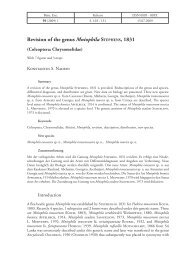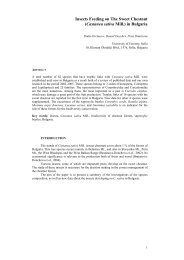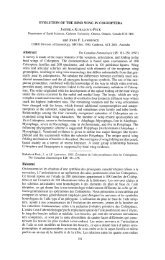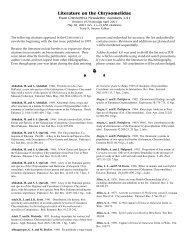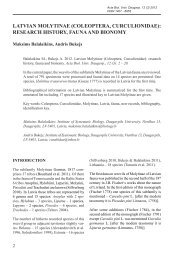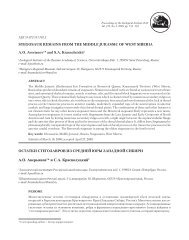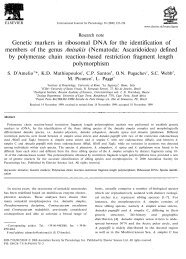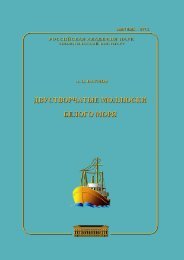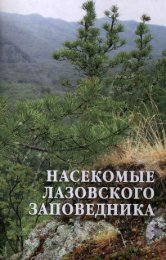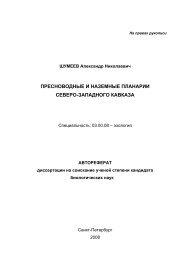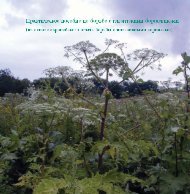Ichneumonidae (Hymenoptera)
Ichneumonidae (Hymenoptera)
Ichneumonidae (Hymenoptera)
You also want an ePaper? Increase the reach of your titles
YUMPU automatically turns print PDFs into web optimized ePapers that Google loves.
Hilszczanski, J. (1994). Impact of insecticides, applied for the control of the nun moth<br />
(Lymantria monacha) on ichneumonids (<strong>Ichneumonidae</strong>: <strong>Hymenoptera</strong>). Sylwan 138 (5):<br />
43 - 49.<br />
Hilszczanski, J., Grodzki, W., Knizek, and Forster, B. (1998). Effects of control treatment<br />
on population dynamics of koino- and idiobiont ichneumonids. Methodology of forest<br />
insect and disease survey in Central Europe. Proceedings, First Workshop of the IUFRO<br />
WP 7.03.10, Ustron Jaszowiec, Poland, 21-24 April, 1998. 81 - 83.<br />
Hintze-Podufal, C. and Thiele, C (1988). Investigations on the microfauna of rose bedeguar<br />
galls. Mitteilungen der Deutschen Gesellschaft fur Allgemeine und Angewandte<br />
Entomologie 6: (4-6): 537 - 541.<br />
Hinz, R. (1987). Rearing species of the genus Ichneumon Linnaeus and allied genera for<br />
biological investigations (<strong>Hymenoptera</strong>: <strong>Ichneumonidae</strong>). Mitteilungen der<br />
Schweizerischen Entomologischen Gesellschaft 60 (1-2): 113 - 120.<br />
Hinz, R. (1991). Investigations on the biology of some species of Ichneumonini<br />
(<strong>Hymenoptera</strong>: <strong>Ichneumonidae</strong>). Mitteilungen der Schweizerischen Entomologischen<br />
Gesellschaft 64 (1-2): 190 - 114.<br />
Hirashima, Y., Abe, M., Tadauchi, O., Konishi, K. and Maeto, K. (1989). The<br />
hymenopterous parasitoids of the diamondback moth, Plutella xylostella (Lepidoptera:<br />
Yponomeutidae) in Japan. Esakia 28: 63 - 73.<br />
Hirashima, Y., Nohara, K. and Miura, T. (1990). Studies on the biological control of the<br />
diamondback moth, Plutella xylostella (Linnaeus). 1. Insect natural enemies and their<br />
utilization. Science Bulletin of the Faculty of Agriculture, Kyushu University 44 (3): 65 -<br />
70.<br />
Hoballah, M.E.F. and Turlings, T.C.J. (2001). Experimental evidence that plants under<br />
caterpillar attack may benefit from attracting parasitoids. Evolutionary Ecology Research 3<br />
(5): 553 - 565.<br />
Hoch, G., Gschwantner, T., Schopf, A. and Villemant, C. (1999). The gypsy moth and its<br />
natural enemies at different population densities in the oak forests of Eastern Austria.<br />
Integrated protection of Quercus spp. forests. Proceedings of the meeting held at Rabat<br />
Sale, Morocco, 26 - 29 October, 1998. Bulletin OILB SROP 22 (3):121 - 128.<br />
Hoch, G., Zubrik, M., Novotny, J. and Schopf, A. (2001). The natural enemy complex of<br />
the gypsy moth, Lymantria dispar (Lep.: Lymantriidae) in different phases of its<br />
population dynamics in eastern Austria and Slovakia - a comparative study. Journal of<br />
Applied Entomology 125 (5): 217 - 227.<br />
Hodges, A.C., Hodges, G.S. and Espelie, K.E. (2003). Parasitoids and parasites of Polistes<br />
metricus Say (<strong>Hymenoptera</strong>: Vespidae) in Northeast Georgia. Annals of the Entomological<br />
Society of America 96 (1): 61 - 64.<br />
Hoffmeister, T. (1992). Factors determining the structure and diversity of parasitoid<br />
complexes in tephritid fruit flies. Oecologia 89 (2): 288 - 297.<br />
53




